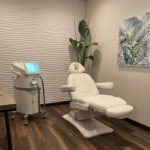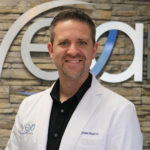
A room in the “medspa” in Dr. Swatts’ practice featuring OptiLight light-based therapy technology. Dr. Swatts says the technology has transformed the practice’s dry eye services and profitability.
By Shane Swatts, OD
Dec. 15, 2021
About six months ago, my wife and practice partner, Leah Ramos, OD, and I asked ourselves, “Now that the practice is running smoothly, how can we generate more revenue doing something we enjoy?” Around the same time, we heard that Lumenis light-based therapy had been FDA-approved for management of dry eye disease. OptiLight* presented a chance to finally focus on the key contributing factors of dry eye disease and build a new practice model: a dry eye medspa.
Six months later, the technology has not only created its own revenue stream, but also, to our surprise, boosted returns from virtually all other aspects of dry eye care, tripling our total dry eye revenues.
Making a Dry Eye Medspa
To create the dry eye medspa, we began with the “med” part of the equation, converting three of our nine exam lanes to dedicated dry eye spaces. The first became an evaluation room with a camera-equipped slit lamp and a monitor for reviewing meibography and educating patients. Another became the OptiLight room, while the third housed thermal procedures (Systane iLux, Alcon; and LipiFlow, Johnson & Johnson Vision). We also perform BlephEx or ZEST (Zocular) in two of the treatment rooms.
My wife and I planned to each work in the medspa two days per week while three optometrists in our main clinic continued to do primary care, referring patients for dry eye evaluations. We didn’t add any new staff members for the medspa, choosing instead to cross-train staff from other areas of the practice. We were pleased to find out that one staff member had previous aesthetics experience.
To complete the “spa” side of the equation, we focused on making dry eye treatment relaxing, pleasant and memorable. We achieve that by pampering our patients. For example, before and after each OptiLight session, patients get a warm towel treatment and face massage by one of our aestheticians. After we opened the medspa, we realized that we were often discussing the relationship between dry eye and skin care, so we merged skin care into the practice. We use a skin care line at all treatment visits and give patients a “rejuvenation kit” containing samples of recommended skin care products. Although we don’t market those products, many patients come back asking how to purchase them. Patients also experience aesthetic improvement to their skin in the periorbital area after OptiLight, but we don’t currently market that component of treatment.
A Walk Through the Patient Experience
When patients enter the dry eye medspa, a technician takes a thorough history and performs a series of tests, such as meibography, osmolarity and NIT-BUT. Next, I do an exam, capturing images of any areas of concern and taking video of gland expression so the patient can see and understand the problem. As we do the exam, the technician documents my recommendations on a tablet.
Finally, I make a diagnosis, educate the patient, and offer treatment recommendations. For example, if a patient has a history of rosacea and I diagnose meibomian gland dysfunction, I would recommend OptiLight and Lipiflow, as well as home-based treatments such as immunomodulators (Cequa, Sun Ophthalmics; Restasis, Allergan; Xiidra, Novartis), omega supplements (De3 Dry Eye Omega Benefits, PRN; HydroEye, Science Based Health), a heat mask and artificial tears.
I verbally review all of my recommendations at the end of the exam, and then leave the room and allow my technician to review the findings, answer additional questions and schedule treatment. The technician shows the patient the list of recommendations and associated fees. We offer a total treatment plan fee for payment on a treatment-by-treatment basis, as well as two discounted fees: a popular VIP member fee (same-day payment with 20 percent off all services and supplies for one year) and a three-month plan (payment in three months for a 10 percent discount).
Once patients choose a payment plan, all the information and treatment instructions are automatically e-mailed to them. The process has worked well for us, removing the doctor from the payment discussion while giving patients clear and easy choices.
Better Outcomes & Triple Dry Eye Revenues
In most cases, patients will benefit from OptiLight, so we schedule four sessions, 2-4 weeks apart. Each treatment takes 8-10 minutes of doctor time. When those four sessions are complete, we perform one of the thermal treatments that we offer. Because treatment times are short, we have time to pamper patients, have conversations and build relationships.
Clinical results have been excellent. Ocular surface disease index (OSDI) scores taken first at the initial evaluation, then before every OptiLight treatment session, and finally at 45 days, show a consistent improvement over the course of treatment. Because changes occur over many weeks, before-and-after images have been helpful in showing patients the aesthetic “side effects.”
Other Articles to Explore
We began seeing revenues from the dry eye medspa just weeks after opening. Before the medspa, dry eye had not been a big revenue center for us, despite offering high-level care. For example, we did perhaps 10 iLux treatments in the first 18 months we owned the device, and we didn’t stock omega supplements or artificial tears in the office because patients rarely wanted to purchase them.
Since we started packaging therapies with OptiLight, every person who receives this treatment also gets a thermal procedure, a 60-day supply of omega supplements, artificial tears, lid cleanser, a heat mask and a skin care rejuvenation kit. Patients love it because they’re getting a thorough treatment and realize the value. Even after treatment is complete, we continue to emphasize the importance of compliance with home treatment and skin care. Keeping an inventory of the recommended products makes it convenient for patients and profitable for the practice.
As a result of bundling around OptiLight, we’ve seen a snowball effect in our revenues. Treatment fees paid for the device in five months, and those fees totaled nearly $80,000 in the first six months. But those numbers don’t capture the full picture of how this model has increased our revenue. Thermal therapies and skin care products have delivered $13,000 more per month. We now have a hard time keeping stock of products that we couldn’t sell before. Overall, each medspa patient generates $1,450 more than the practice’s primary care patients.
This jump in revenue has happened within the context of effective patient care. I can now look patients confidently in the eye and tell them that we can make long-lasting improvements in how they look and feel. Rather than feeling frustrated with the limitations in our dry eye toolbox, we are excited to be able to offer a treatment that addresses the root causes of dry eye disease, resulting in happy patients and professional fulfillment.
 Shane Swatts, OD, is the owner of Eastern Virginia Eye Associates and The MedSpa at EVEA in Chesapeake, Va.
Shane Swatts, OD, is the owner of Eastern Virginia Eye Associates and The MedSpa at EVEA in Chesapeake, Va.
* Currently, no other light-based therapy is FDA approved for the management of dry eye disease.

























